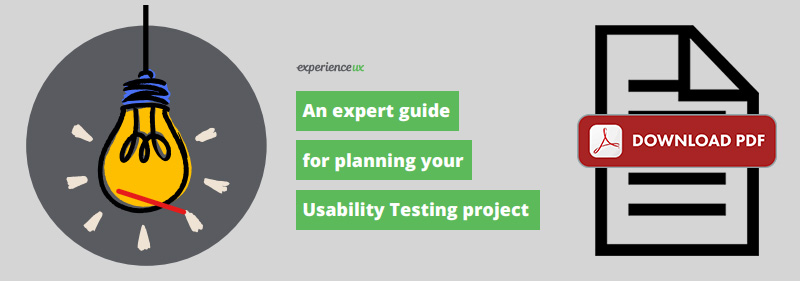Sometimes questions are more important than answers
What is an expert review?
An expert review is where a usability expert uses their knowledge and experience of testing websites with users to walk through a website in the shoes of a typical user. The expert will spot problems and recommend changes to improve usability when budgets and timescales don’t allow for user research.

An expert review aims to identify UX issues quickly
An expert review or website audit is an inspection method designed to identify usability problems in an online product or service. The review is carried out by a small group of usability experts (between 1 and 4), who analyse the product or service to identify any potential usability issues. This expert usability review is one of the few methods within the user-centred design process that does not involve any direct contact with end-users.
Why the formal method can be too rigid
The mainstream literature on this method often refers to the more formal method of Heuristic Evaluation, which refers to experts reviewing a graphical user interface for its adherence to common usability guidelines (or heuristics).
Whilst the Heuristic Evaluation is a common method used in more formal or academic circles, it could be argued that this method is too rigid and often fails to meet the needs of most clients. Assessing an interface by simply checking boxes to determine where it does or does not meet so-called usability guidelines does not place enough value upon the context of use, or the goals of the system. The evaluation relies solely upon usability guidelines that are often years old and the result of research on graphical user interfaces, which may be completely different to the one being reviewed.
Many guidelines are well-meaning, but when adhered to by the letter, they can often lead to poor usability decisions because the designer does not take into account their specific users, the context they will be using the system, and the goals of the product or service. Simply following guidelines can be misleading and can give a false sense of security that an interface is usable, when in fact it is not. For this reason, the following flexible expert usability review method is better suited to meeting customer and business needs.
An alternative approach
This expert review approach pays full attention to the context, the nature of the system being evaluated, and the goals of the business. The technique can be used more flexibly on screen-based technology as well as physical products and services and aims to fully understand user needs rather than reducing them down to a checklist.
Start with the end-user in mind
This method first requires an understanding of who the users of the system are and what the business goals are, so the initial brief is crucial. The expert develops the information on the end-users into user profiles or personas (if these have not already been provided) and works with the client to narrow down the personas into one or two priority users. Each priority user should then be looked at in more detail to outline their typical goals and scenarios when using the product or service. Once this has been done, the expert usability review can begin.
Always try to put yourself in the shoes of the user
For each of the priority users, the expert attempts to achieve the priority users’ goals with the product or service in question. By placing themselves in the shoes of the potential user, the expert will examine the interface in context to make recommendations that help the customer achieve their user goals and the product owner to better achieve their business goals.
The method requires an expert to carry out the review to provide the experience (of conducting usability tests and user research) to fully predict the potential pitfalls in the user journey. The most important skill of the expert is to extract their own personal perspective away from the review in order to provide an objective analysis.
The benefits
Businesses are able to get fast, low-cost, independent feedback at almost any stage of their product or service development life-cycle. This is supported by detailed feedback on each step of a typical user journey along with a more strategic perspective on how the product or service may need to refocus upon customer needs in order to truly fulfil its business strategy.
Conclusion
The more traditional heuristic usability evaluation can be inflexible in many modern projects as it relies solely upon the experts to analyse the interface for its adherence to usability guidelines. Whilst usability guidelines can be extremely useful to help guide decisions, they can also be dangerous to follow without taking into account the full context of use. An alternative method that takes into account the full user journey, and the goals of the product or service, is better suited to today’s business needs.
Although the expert usability review does not offer the level of confidence or depth that watching real users does, it is an extremely useful tool to offer independent advice quickly and easily on a product or service. As this method is quick to conduct it requires less budget than a usability test and can therefore be used multiple times throughout a project life-cycle.
You may also like
More UX Methods Questions
Usability testing is a way to see how easy to use something is by testing it with real users. Users are asked to complete tasks, typically while they are being observed by a researcher, to see where they encounter problems and experience confusion. If more people encounter similar problems, recommendations will be made to overcome these usability issues.
User-centred design is a process or set of tools used to design a service which focuses on what users need at the very beginning and continues throughout development until launch. Typically services are designed from a technical and business perspective, with consideration for users added in later. Instead, User-centred design ensures the service focuses on what users need before balancing this with the technical and business requirements.
Wireframing is a way to design a website service at the structural level. A wireframe is commonly used to lay out content and functionality on a page which takes into account user needs and user journeys. Wireframes are used early in the development process to establish the basic structure of a page before visual design and content is added.
Website prototypes are interactive demos of a website. These are often used to gather feedback from project stakeholders early in the project lifecycle, before the project goes into final development
User requirements capture is a process used to understand what typical users will need from a service which is about to be designed. Users are observed using similar services and interviewed about the ways they go about planning and completing their goals. This information is used to identify a list of content, features and functionality the new service must have in order to satisfy the needs of its users.
Customer profiling is a way to create a portrait of your customers to help you make design decisions concerning your service. Your customers are broken down into groups of customers sharing similar goals and characteristics and each group is given a representative with a photo, a name, and a description.
Card sorting is a technique that involves asking users to organise information into logical groups. Users are given a series of labelled cards and asked to organise and sort them into groups that they think are appropriate. Card sorting helps you to design an information architecture, workflow, menu structure or website navigation paths.
A user journey is a path a user may take to reach their goal when using a particular website. User journeys are used in designing websites to identify the different ways to enable the user to achieve their goal as quickly and easily as possible.
Focus groups are a research method used to gather feedback and opinions from customers. Each person in the group is encouraged to participate in a discussion which is pre-planned by a researcher and is guided by a facilitator. Focus groups are typically used to gauge opinion and gather information from users about products, services, and features before they have been developed.
Remote usability testing is a way to test how easy to use a website is with users who are in a different geographical location. Traditional usability testing brings users and researchers together in one place to conduct the test, whereas remote usability testing allows the researcher and user to be in different locations while the test is completed.
An expert review is where a usability expert uses his/her knowledge and experience of testing websites with users to walk through a website in the shoes of a typical user. The expert will spot problems and recommend changes to improve usability when budgets and timescales don’t allow for user research.
Service design makes a service easier to use, more useful and more desirable for the customers who need to use it: the service user. Whether creating an entirely new service or improving an existing one, service design focuses on what customers really need at each stage of their interaction with an organisation.
Ethnography is a study through direct observation of users in their natural environment rather than in a lab. The objective of this type of research is to gain insights into how users interact with things in their natural environment.
Tree testing is a way of evaluating a proposed site structure by asking users to find items based on the sites organisation and terminology. This online test only displays the navigation links and removes any additional clutter.
Find Out More
Let’s Chat
If you’re ready to introduce the innate power of human centeredness to your products, services and brand, drop me an email today.
01202 293652 alicarmichael@experienceux.co.uk

